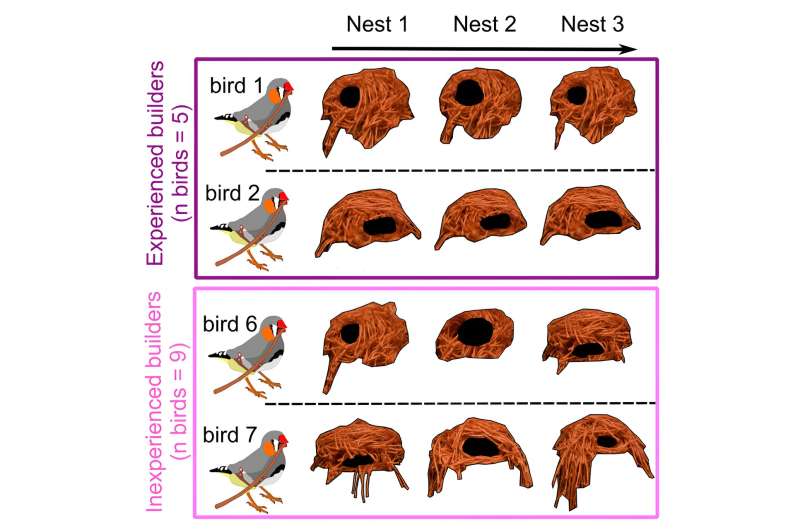This article has been reviewed according to Science X's editorial process and policies. Editors have highlighted the following attributes while ensuring the content's credibility:
fact-checked
peer-reviewed publication
trusted source
written by researcher(s)
proofread
Birds' nests express their unique style and past experiences, study finds

Walking through a town or city, you will encounter buildings with diverse shapes and sizes. These unique styles exist in part because the buildings were constructed by different architects, engineers and builders.
Birds are also architects, engineers and builders. Our research, published in iScience, finds that, similar to human architecture, individual birds build nests in their own unique style. Experienced birds build with more consistent style and use fewer material resources than inexperienced birds.
Animal architecture
Architecture impacts our everyday lives, allowing us to adapt to and thrive in various climates. Humans build different structures to achieve different goals: farms to grow and store food, castles and skyscrapers to display wealth, homes for shelter or as a place to raise a family.
The same is true for other species. Bees build hives and honey combs to store and protect food. Spiders spin webs to catch prey. Beavers build dams to create a pool. Many species of birds construct nests for shelter or to raise their chicks.
Building architecture allows animals to shape their environments to better meet specific needs.
Architectural styles
Human structures look different, even when those structures share a similar purpose. This might reflect differences in culture and available resources.
In western societies, houses tend to be cuboids made from stone, wood and glass. Plains Indigenous Peoples make conical tipis from wood and bison hides. Inuit peoples use ice and snow to make spherical igloos. East African Maasai peoples build cylindrical manyatta huts from earth, grass and cow dung.
There are differences in architectural style among individuals within the same culture using the same materials.
Visualize your home: the size and shape of each room, position of doors and windows, arrangement of furniture. Now compare your visualized blueprint to the blueprint of a friend's house. They likely look quite different, as humans have individual variation in architectural style.
Our research suggests the same is true for animal architects: animals also build structures with individual variation in architectural style.
Avian architects
Birds are among the most well-known builders in the animal world. Many avian species build nests to create safe, warm environments to incubate their eggs and raise chicks. Nest building is a key task that individuals must complete to successfully reproduce.
Our team, the Animal Cognition Research Group in the Department of Psychology at the University of Alberta, ran an experiment testing whether birds built nests in their own individual style.
We studied zebra finches, small songbirds native to Australia. Zebra finches have been bred in captivity for years and are common in pet stores and scientific research. These birds are ideal for our test, as males build many nests in short periods of time using a range of materials.
We measured the sizes and shapes of multiple nests built by the same zebra finches. Comparing nests built by the same male found similarities in style. Comparing nests built by different males found dissimilarities in style. This shows individuals do build nests in their own unique and repeatable style.
Psychology of style
The minds of human architects can be studied through analyzing the style in which they build. This gives insights on their understanding of technology and their cultural influences or social values.
Some ancient structures, like the pyramids of Giza, Stonehenge and Mayan structures, are aligned to the sun and stars. This demonstrates ancient architects had the ability to precisely plan and execute designs with great detail. It also suggests that celestial bodies held some significance to these cultures, perhaps for mapping landscapes or the passage of seasons.
An individual architect might specialize in building structures of a particular style, such as Gothic, Art Deco, Victorian or Brutalist. Their style might change over time as the architect learns and refines their skills through experience.
These examples show how the psychology of style can be analyzed in human architects. We wanted to investigate the psychology of style, specifically learning from experience, in our zebra finches.
Style and experience
We gave one group of zebra finches practice building five nests, giving each male opportunities to learn from this nest-building experience. A second group of zebra finches had no practice building. These males had never built a nest before the start of the experiment. Both groups then built nests so that we could compare the nest style built by the two groups.
Experienced birds had more consistent nest style and used less material compared to inexperienced birds. This indicates that learning opportunities influence nest style.
Practice building nests allows birds to develop motor skills and better manipulate materials. Birds also remember past outcomes of nests and will replicate successful design elements.
Individual style might develop from differences in learning opportunities. Maintaining a style might even be beneficial. Creating consistent nests while using fewer resources may be advantageous, especially if the style has been successful or resources are limited.
We can learn a lot about how both human and animal architects adapt and respond to their surroundings and culture by studying the structures they build. Our research also shows home isn't just where the heart is … it's also in the brain.
More information: Benjamin A. Whittaker et al, Zebra finches have style: Nest morphology is repeatable and associated with experience, iScience (2023). DOI: 10.1016/j.isci.2023.108194
Journal information: iScience
Provided by The Conversation
This article is republished from The Conversation under a Creative Commons license. Read the original article.![]()


















